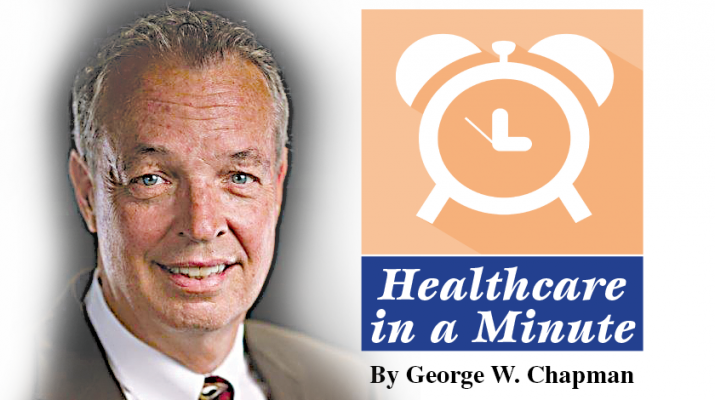By George W. Chapman
According to a study sponsored by the Journal of the AMA, ransomware attacks on healthcare organizations have doubled over the last five years.
Last year, 374 reported attacks impacted the personal health information (PHI) of about 42 million people. The attacks are increasing in both frequency and sophistication. Worse yet, researchers believe these attacks are under reported. The top targets are health clinics, followed by hospitals, ambulatory surgery centers, mental health providers, dental practices and post-acute care providers like nursing homes. Larger, highly networked providers are most vulnerable because employees can access information remotely via cell phones or personal computers, making it easier for hackers.
The healthcare industry was notoriously slow to adopt electronic medical records. Ironically, this made ransomware attacks possible. Healthcare organizations are required to report any breaches to their patients. CommonSpirit Health, the nation’s second largest nonprofit hospital system, faces a class action lawsuit for “failing to exercise reasonable care” to protect PHI. 600,000 records were hacked. Scripps Health will pay out $3.5 million to 1.2 million patients impacted by a breach in 2021. Each plaintiff will receive a minimum $100 with some receiving $7,500 for extraordinary suffering and out-of-pocket expenses.
Virtual Mental Health Surges
A survey recently conducted by American Well (AmWell) revealed 62% of respondents prefer virtual visits, even though it is relatively safe to return to in-person visits. Virtual provider Doctor On Demand reports a 50% increase in business since the fall. The pandemic has exacerbated ongoing economic, environmental and social issues. Notable increases in virtual visits were among men, seniors, millennials and Gen Z. A national BCBS study revealed millennials, versus baby boomers, are more likely to associate the impact of mental health upon physical health. They are twice as likely to develop Type 2 diabetes and almost three times more likely to have coronary heart disease.
92% of millennials feel the pandemic has negatively impacted their mental health. Consequently, alcohol use, smoking and vaping are increasing among that generation. As the millennial and Gen Z generations become more dominant in the overall US population, industry experts predict much more emphasis will be placed on long-neglected behavioral health care.
FDA Approves Abortion Pill
Mifepristone or RU-486 is now available at local pharmacies, retail pharmacies like CVS and Walgreens and via mail order. The drug can be used up to 10 weeks gestation. To protect a patient’s privacy, the DOJ ruled the pill can be delivered via mail. No one must appear in person at a pharmacy to receive the drug. The FDA requires instructions on how to use the pill; information regarding the risks; shipping services must provide tracking; it must be dispensed and delivered in a timely fashion. Pharmacists are one of the most trusted providers, yet they are grossly underutilized. Most people would like to see them provide more services like testing for flu and strep throat and be a more active partner with primary care providers. By providing additional services, pharmacists can relieve a lot of the pressure on physician practices and community clinics.
ACA Enrollment Up
As of December 15, 2022, enrollment is up 18% on the exchanges from the same time in 2021, or about 1.8 million enrollees. The healthcare exchanges offer individuals without employer sponsored healthcare various commercial insurance plans. Premiums are based upon the individual’s income.
$1.7 Trillion Omnibus Spending Package
It contains several key healthcare items. Medicare reimbursement for physicians was to be cut 4.5% this year. Instead, the cut was reduced to 2% in 2023, but then another 3.5% cut in 2024. This cut comes at a time when practices are plagued with nursing shortages and inflation still around 7%-8%. $9.2 billion is earmarked for the CDC which is a $760 million increase from last year. Half of the increase is for future pandemic preparedness. Telehealth flexibility, which was to expire this spring, has been extended another two years. This includes paying providers the same for a virtual visit as an office visit. Medicare will cover marriage and family therapists and counselors and spend more on mobile mental health crisis providers. The spending package also continues enhanced payments to rural hospitals with high Medicare occupancy for two more years.
More Transparency
Per executive order, our 7,000 hospitals (for profit and nonprofit alike) must indicate who owns them and what the nature of that ownership entails. The information will be available on the CDC website. Skeptics wonder what is the point? There are no “secret” hospital owners. All of this is readily available on IRS form 990. In any event, it is another way for Medicare to make healthcare more transparent to the consumer. Skilled nursing facilities have been required to do this for years.
NYC Nurse Strike
As of this writing, more than 7,000 nurses from Mount Sinai and Montefiore hospitals are on strike for better wages and safer staffing levels. The nursing situation in these two hospitals is not much different than the nursing situation in most of our 7,000-plus hospitals across the country. The pandemic has wreaked havoc on the nation’s physical and mental health. More than a million people have died. The lingering impact of virus variants continues to swamp emergency rooms which end up treating admitted patients in hallways because inpatient beds upstairs are at capacity. Because of the nursing shortage, hospitals have had to close beds that cannot be safely staffed. So, capacity has been severely hampered. Hospital-based nurses and physicians are literally the front line in a “war” that has lasted three long years. The constant stress has caused a lot of these providers to either quit or retire early, leaving fewer of their colleagues behind to treat the higher patient load. And there seems to be little relief in sight. But increasing wages and adding staff requires, well, money. And cash-strapped hospitals just don’t have it. Hospital reserves are notoriously low. Unlike just about any other business, hospitals (and physicians) cannot solve the money problem by simply raising prices. Virtually no one would end up paying their new price because government and commercial payers set their reimbursement in advance. Based on federal and state budgets, there won’t be enough financial relief this year from either Medicare or Medicaid. And there won’t be much relief coming from commercial insurers because they tend to mimic what Medicare pays. Frustrated and exhausted nurses are on strike against their cash-strapped employers. But hospital administration is not the enemy. At some point, the AHA, ANA and AMA need to band together and “strike” against the payers.
 George W. Chapman is a healthcare business consultant who works exclusively with physicians, hospitals and healthcare organizations. He operates GW Chapman Consulting based in Syracuse. Email him at gwc@gwchapmanconsulting.com.
George W. Chapman is a healthcare business consultant who works exclusively with physicians, hospitals and healthcare organizations. He operates GW Chapman Consulting based in Syracuse. Email him at gwc@gwchapmanconsulting.com.

